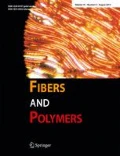Abstract
Shear rigidity of woven fabrics is an important property that defines the behaviour of fabrics when they are required to conform to three dimensional forms, including the human body in the case of apparel textiles or preforms and prepregs used for production of fibrous polymer composite components. Typically, shear rigidity is measured using complicated and expensive equipment. This paper presents the study of the influence of weave patterns on the shear behaviour of fabrics using a simple and precise testing method. The shear behaviour of eleven cotton fabrics in total, utilizing different weaving patterns and different yarn densities was investigated. Specimens of different dimensions were also tested to determine the influence of the specimen dimensions on the measured characteristics. The investigation resulted in a correlation between the shear behaviour and the different weaving patterns. Specifically, it was shown that weave patterns that are closer to the plain weave (firm weaves) are more restricting to the yarn rotation than loser weave patterns. Furthermore, the results show the relationship between shear behaviour and specimen dimensions as well as yarn density. Increasing the length of the specimens (the dimension of the specimen parallel to the direction in which the shearing force is applied) or decreasing the width of the specimens (the dimension of the specimen vertical to the force application) also leads to an increase of the shear rigidity.
Similar content being viewed by others
References
H. Sun and N. Pan, Compos. Struct., 67, 317 (2005).
C. Mack and H. M. Taylor, J. Text Inst. Trans., 47, T477 (1956).
M. Nguyen, I. Herszberg, and R. Paton, Compos. Struct., 47, 767 (1999).
P. Buckenham, J. Text. Inst., 88, 33 (1997).
S. M. Spivak and L. R. G. Treloar, Text. Res. J., 38, 963 (1968).
I. Taha, Y. Abdin, and S. Ebeid, Fiber. Polym., 14, 338 (2013).
G. Lebrun and J. Denault, “American Society of Composites, Fifteenth International Conference”, pp.659–667, College Station, TX, USA, 2000.
J. Cao, R. Akkerman, P. Boisse, J. Chen, H. S. Cheng, E. F. de Graaf, J. L. Gorczyca, P. Harrison, G. Hivet, J. Launay, W. Lee, L. Liu, S. V. Lomov, A. Long, E. de Luycker, F. Morestin, J. Padvoiskis, X. Q. Peng, J. Sherwood, T. Stoilova, X. M. Tao, I. Verpoest, A. Willems, J. Wiggers, T. X. Yu, and B. Zhu, Compos. Part A Appl. Sci. Manuf., 39, 1037 (2008).
J. Lindberg, B. Behre, and B. Dahlberg, Text. Res. J., 31, 99 (1961).
P. Grosberg and B. J. Park, Text. Res. J., 36, 420 (1966).
S. Kawabata, M. Niwa, and H. Kawai, J. Text. Inst., 64, 62 (1973).
J.-L. Hu and Y.-T. Zhang, Text. Res. J., 67, 654 (1997).
S. Vassiliadis, A. Kallivretaki, P. Frantzeskakis, and C. Provatidis, Int. J. Cloth. Sci. Technol., 24, 15 (2012).
R. J. Bassett, R. Postle, and N. Pan, Text. Res. J., 69, 866 (1999).
M. Y. Leung, T. Y. Lo, R. C. Dhingra, and K. Yeung, Res. J. Text. Appar., 6, 39 (2002).
Ž. Penava, D. Š. Penava, and M. Nakić, J. Eng. Fabr. Fibers, 10, 114 (2015).
T. Chen, P. Shi, J. Zhang, Y. Li, X. Tian, J. Lian, T. Duan, and W. Zhu, Appl. Surf. Sci., 459, 129 (2018).
Author information
Authors and Affiliations
Corresponding author
Rights and permissions
About this article
Cite this article
Inogamdjanov, D., Matsouka, D., Vassiliadis, S. et al. Low Stress Shear Behaviour of Cotton Fabrics. Fibers Polym 21, 1355–1361 (2020). https://doi.org/10.1007/s12221-020-9037-2
Received:
Revised:
Accepted:
Published:
Issue Date:
DOI: https://doi.org/10.1007/s12221-020-9037-2


